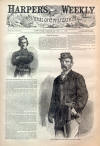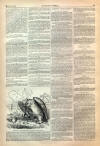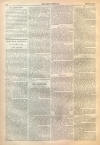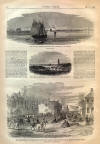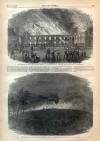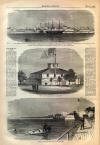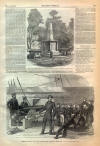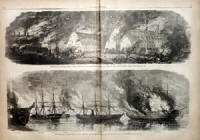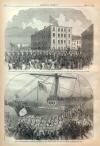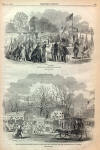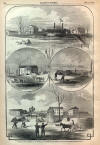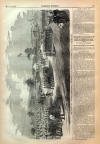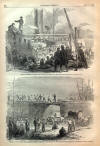Annapolis
|
|
This Site:
|
MAY 11, 1861.] HARPER'S WEEKLY 295 THE NAVAL MONUMENT IN THE GROUNDS OF THE NAVAL SCHOOL AT ANNAPOLIS.(Previous Page) o'clock the marines, who had been quartered in the barracks, fired them, and came on board the Pawnee. This movement was premature, for it was the intention to fire all the buildings simultaneously. A party of officers, meantime, were going through the different buildings and ships, distributing waste and turpentine, and laying a train so as to blow up the Dry Dock. They were engaged in this work until two o'clock, when the train was fired. At three o'clock the Yankee, to the Captain of which, Charles Germain, much credit is due, came along and took the Cumberland in tow, the Pawnee taking the lead. All the vessels beat to quarters, the guns were manned, and every thing was in readiness to carry out the threat of Commodore McAuley, that if a gun was fired from either shore he would level both Portsmouth and Norfolk. At this time the scene was indescribably magnificent, all the buildings being in a blaze, and explosions here and there scattering the cinders in all directions. "The Yankee left the yard with the Cumberland in tow about three o'clock. The fleet proceeded down the river until nine o'clock, when it came to anchor within a mile of the point where wrecks were known to have been sunk for the purpose of obstructing the navigation. Boats were sent out to take soundings in order to ascertain whether some other passage than the regular channel could not be found. All efforts proved unsuccessful, so the fleet raised anchor and forced their way directly through the wrecks. The Cumberland caught one of the sunken vessels and carried it along with her, and apprehensions were at first entertained that she might be carried on to Sewell's Point, where it was supposed that the rebels had erected batteries. Meantime the Keystone State came up from Washington with marines, and by her help and that of the Yankee, the Cumberland was towed into deep water and the wreck was disentangled. She then went up under protection of the guns of Fort Monroe and came to anchor. While the vessels lay there, four men, who had been employed in the Navy-yard, succeeded in making their way down the river, and reported that they left everything in flames, and the smoke and flames could easily be seen from the Cumberland. The rebels, too, they reported were fearful of attempting to arrest the flames, because they apprehended that a train was laid to blow up the buildings. On page 298 we illustrate the DEPARTURE OF THE THIRTEENTH AND SIXTY-NINTH REGIMENTS from New York. They left on Tuesday 23d, the 13th in the Marion, the 69th in the James Adger, and arrived safely at Annapolis. The 13th consists of Brooklyn boys, and is one of the finest Regiments in the service. The 69th is Colonel Corcoran's Irish Regiment, the same which refused to turn out in honor of the Prince of Wales. It is now very earnest in supporting the Government, and might have been four thousand strong if uniforms and arms could have been supplied. Both of these Regiments will do good service On page 299 we illustrate the NEW TEMPORARY BARRACKS WHICH HAVE JUST BEEN ERECTED ON THE PARK AT NEW YORK, AND THE ENCAMPMENT ON THE BATTERY. In the sheds on the Park six thousand men can be fed. The Battery Encampment contains at the present time some two thousand five hundred men. On page 300 we illustrate the EARTHWORKS WHICH WERE THROWN UP TO PROTECT THE ARSENAL AT ST. LOUIS BEFORE THE ARMS WERE REMOVED FROM THENCE BY THE ILLINOIS TROOPS. The United States officer who sent us the sketches likewise kindly supplied us with the following account : " The United States Arsenal at St. Louis is an arsenal of repairs and alterations, large quantities of arms being annually sent there from the Government depots, and also from the several States to be placed in a proper condition for service. Here, also, is manufactured and put up most of the fixed ammunition used In our service. "The Arsenal is defended by about four hundred and forty troops, Artillery and Infantry, under the command of Captain W. Lyon, 2d Infantry." On page 304 we publish two illustrations of the VOLUNTEERS ON THEIR WAY TO WASHINGTON—one representing the Seventh on board the Boston, en route for Annapolis, the other the repairing of a bridge on the road to the Junction by the Eighth Massachusetts Regiment. Both of these were from sketches of our special artist with the Seventh Regiment. The three boys carrying a United States flag who are shown in the latter picture were Maryland boys, who met the troops on their way and begged to be allowed to enlist. The Herald correspondent tells the following stories of the labors of the Eighth Massachusetts men on the way: " At four A M. on Wednesday, Company 2, Captain Clark, and Company 6, Captain Nevins, forming the advance-guard, marched to the railway station, where they found an engine and two or three passenger cars, ready to start. This was the work of the Massachusetts regiment, with General Butler, who had found the engine dismantled. ' Who knows how to make an engine?' asked General Butler. Six practical machinists stepped from the ranks, but one claimed the privilege of making repairs. 'I made that engine,' said he, and pointed out his private mark. "The Sixth and Second companies were unable to proceed in the cars more than three or four miles, because the rails were torn up. Then commenced the march. Scouts and skirmishers were thrown out in front and on each side. Rails torn from switches at Annapolis, too short for use, and having to be pieced out with joists of timber, replaced the missing rails, excepting where they could be found in the bushes beside the track. The rails and timber we recarried on baggage cars, which were pushed by the men. On the front car was a howitzer, with guards and gunners. All day they marched, mending the track wherever it needed mending. "About sunset they reached the remains of the bridge near Millersville, twenty feet high and sixteen feet long, which had been burned, and the engineer corps of the Regiment, assisted by the Massachusetts men, who had done good service throughout the day in repairing the track, rebuilt the bridge and relaid the rails, so that after a heavy shower, which wet the men through, they were enabled to proceed. After night-fall the march continued, through swamps and mist, out of which chill blasts came. Company G had been ordered to roll up its over-coats, and had only blankets. Occasional rails had to be replaced. The baggage cars were still to be pushed on by men who had no sleep for twenty-four hours, and who had experienced unusual heat and unusual chillness by turns for twenty hours." FORT SUMTER.AN IMPROMPTU, BY A VIRGINIAN LADY STILL IN THE UNION. LOUD be the note of triumph rung, Forgot the battles Homer sung; Let all men tinder heaven see What Southern chivalry hath done : The day that saw Fort Sumter won, Seven thousand conquered seventy ! Let heroes, from Thermopylae To Waterloo, forgotten be; Our faith in them is shaking. Their deeds were rather grand, I know; But not, though we have praised them so, At all like Sumter's taking. Thank God ! if 'twas a bloodless fig ht, Even brother foes in this unite; May only such our heaven see! But none can take from Southern men The fame of that great battle, when Seven thousand conquered seventy! BALTIMORE, April 18, 1861. MIDDIES LEARNING THE ROPES AT THE NAVAL SCHOOL ON BOARD THE " CONSTITUTION," ANNAPOLIS.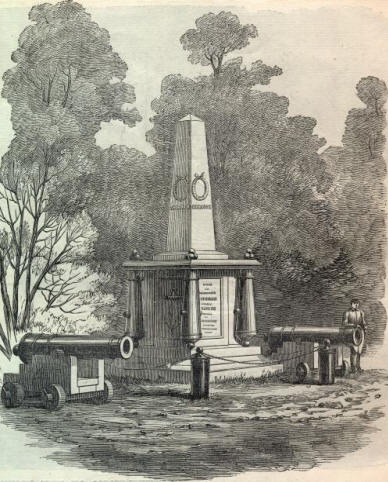 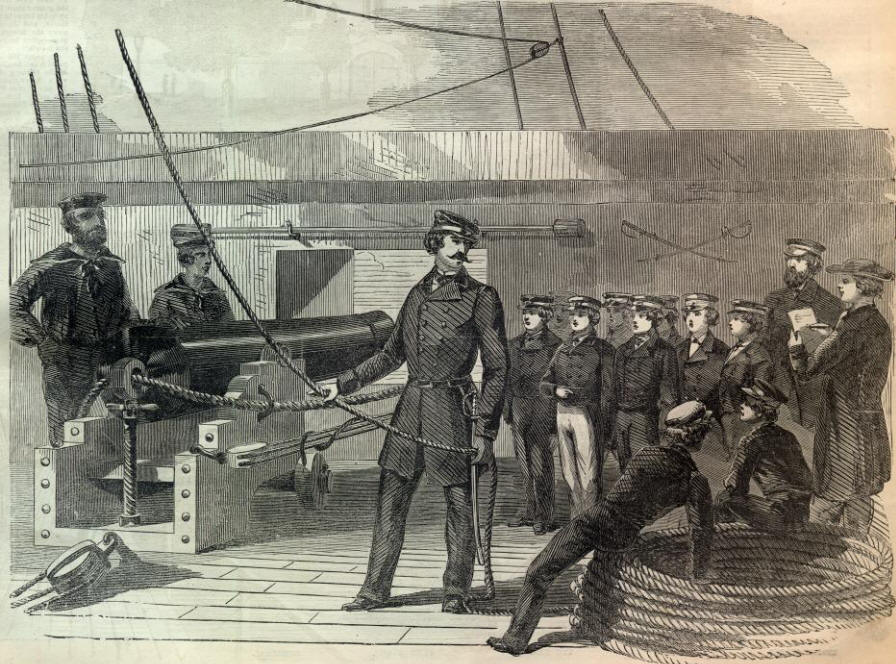 |
|||||||||||||||||||||
|
|
||
|
|
Site Copyright 2003-2018 Son of the South. For Questions or comments about this collection, contact: paul@sonofthesouth.net |
|
|
Are you Scared and Confused? Read My Snake Story, a story of hope and encouragement, to help you face your fears. |
||
